Abstract
A simple and economical method was developed for using biotinylated DNA probes to hybridize with bacterial colonies belonging to the various categories of diarrhea-causing Escherichia coli. Simplification and cost containment were achieved by using Whatman no. 541 filter papers instead of nitrocellulose, by minimizing the concentration of proteinase K (an expensive but necessary reagent used to pretreat the colony blots prior to hybridization with biotin-labeled DNA probes) and by reusing hybridization solution containing labeled probe DNA. After exposing the colony blots to lysing solution and steam, followed by lysozyme (1.5 mg/ml), sucrose (25%), and proteinase K (10 micrograms/ml) treatments, biotinylated probes were used to detect enterotoxigenic, enteropathogenic, enterohemorrhagic, diffuse adherence, and enteroinvasive categories of diarrhea-causing E. coli with a high level of sensitivity and specificity. Three independent observers who were experienced in reading DNA blots recorded remarkably similar results, while less satisfactory results were obtained when the blots were read by an inexperienced observer. This technique will be useful in laboratories in which radioactive isotopes are unavailable or impractical and in which budgets are restricted.
Full text
PDF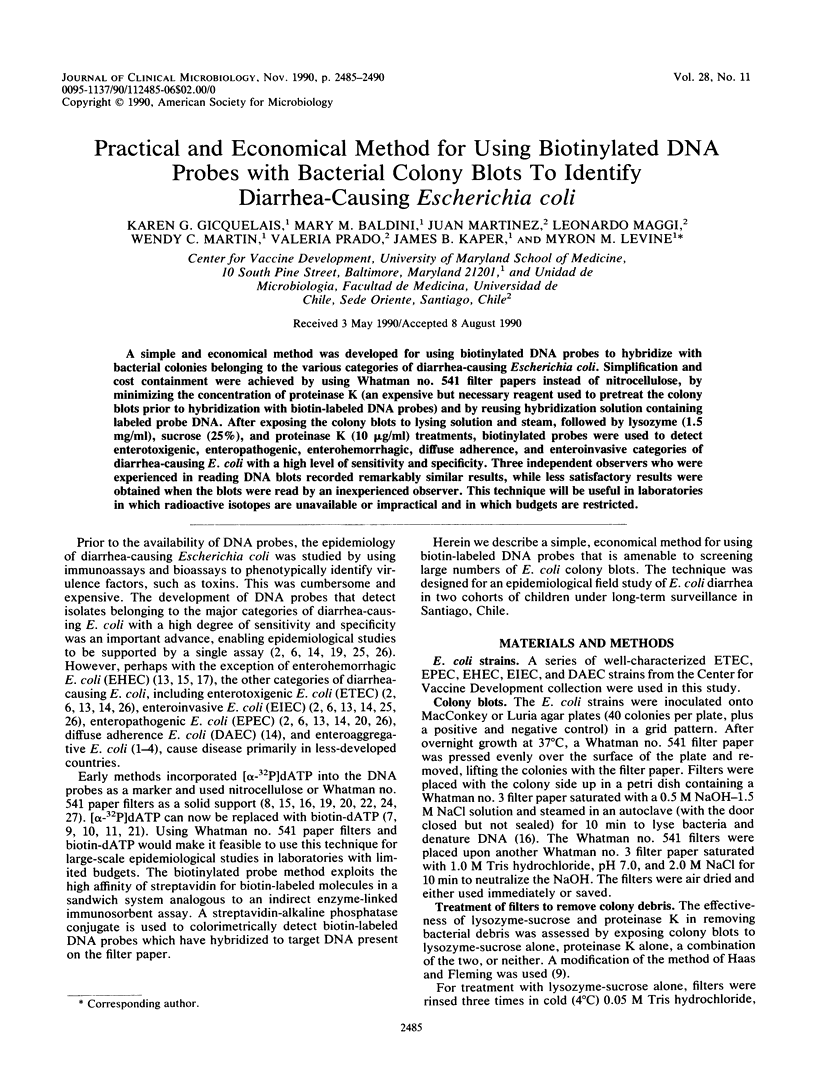
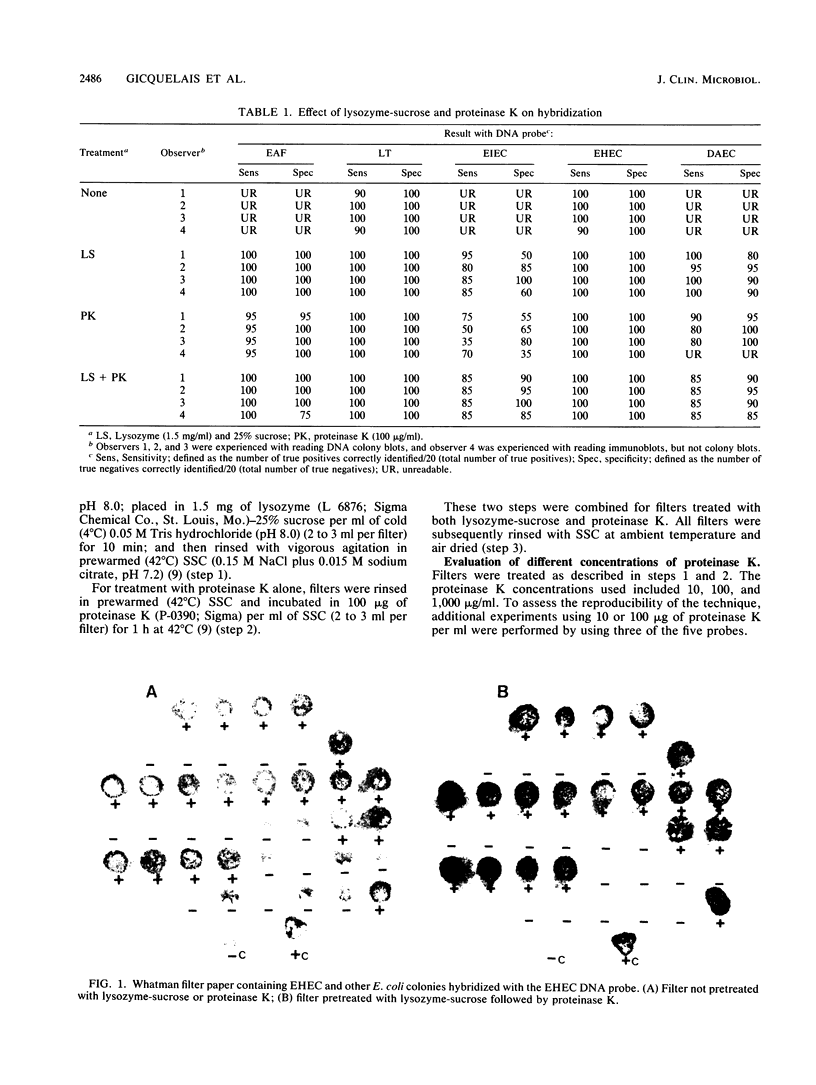
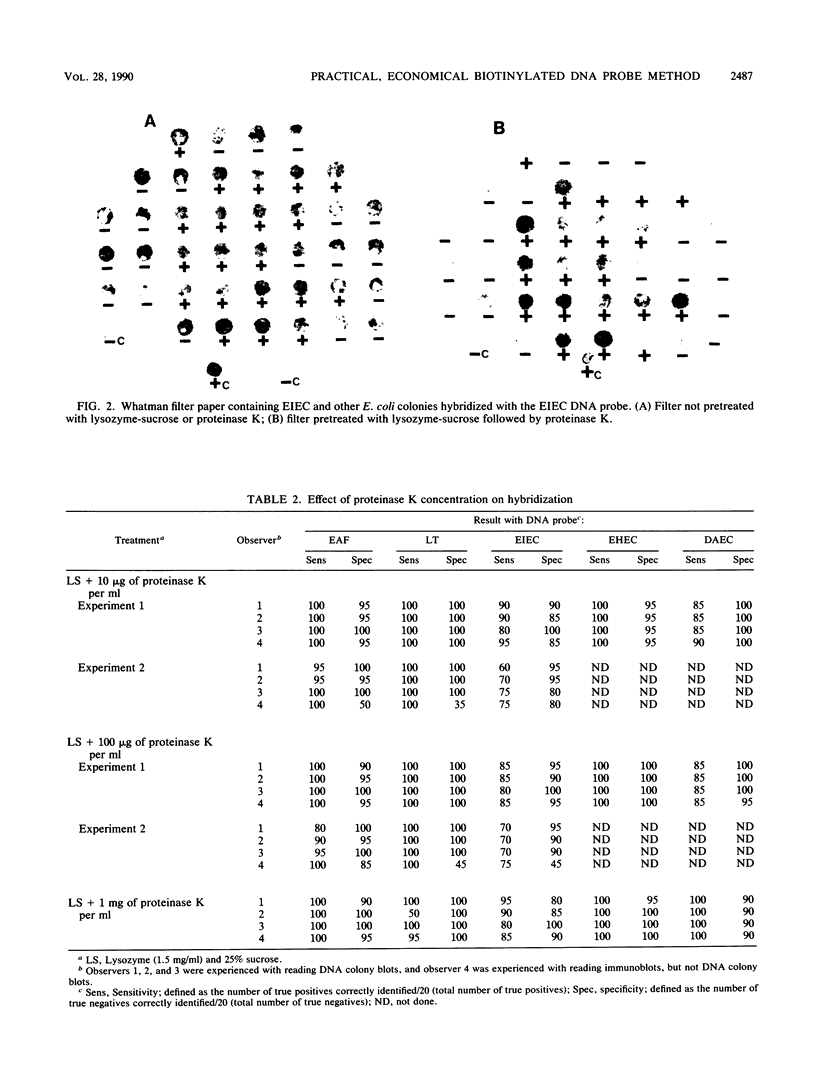
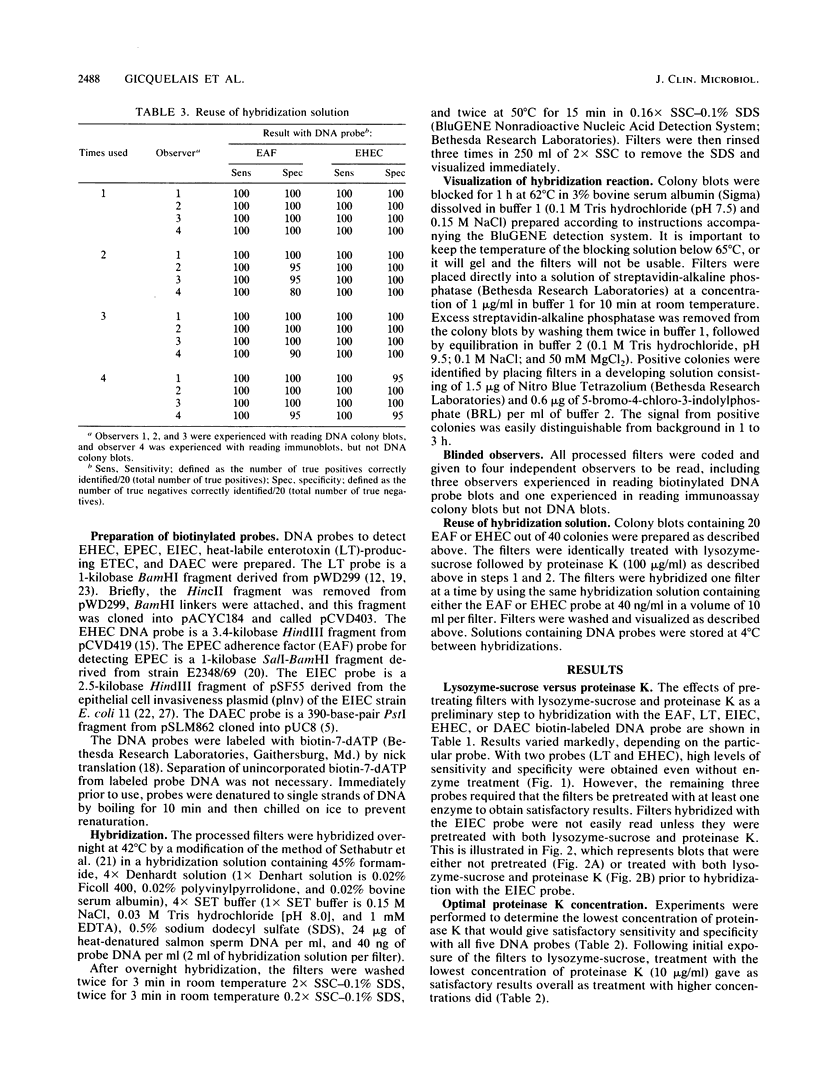

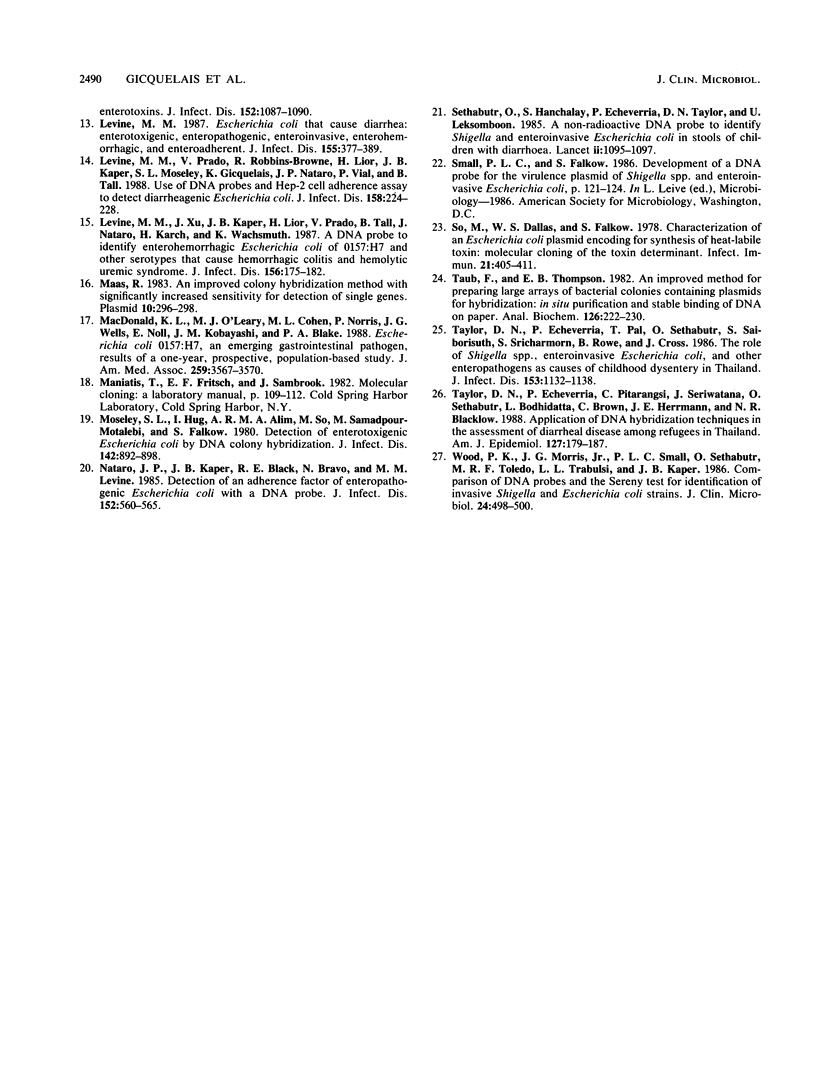
Images in this article
Selected References
These references are in PubMed. This may not be the complete list of references from this article.
- Baudry B., Savarino S. J., Vial P., Kaper J. B., Levine M. M. A sensitive and specific DNA probe to identify enteroaggregative Escherichia coli, a recently discovered diarrheal pathogen. J Infect Dis. 1990 Jun;161(6):1249–1251. doi: 10.1093/infdis/161.6.1249. [DOI] [PubMed] [Google Scholar]
- Bhan M. K., Bhandari N., Sazawal S., Clemens J., Raj P., Levine M. M., Kaper J. B. Descriptive epidemiology of persistent diarrhoea among young children in rural northern India. Bull World Health Organ. 1989;67(3):281–288. [PMC free article] [PubMed] [Google Scholar]
- Bhan M. K., Khoshoo V., Sommerfelt H., Raj P., Sazawal S., Srivastava R. Enteroaggregative Escherichia coli and Salmonella associated with nondysenteric persistent diarrhea. Pediatr Infect Dis J. 1989 Aug;8(8):499–502. doi: 10.1097/00006454-198908000-00005. [DOI] [PubMed] [Google Scholar]
- Bhan M. K., Raj P., Levine M. M., Kaper J. B., Bhandari N., Srivastava R., Kumar R., Sazawal S. Enteroaggregative Escherichia coli associated with persistent diarrhea in a cohort of rural children in India. J Infect Dis. 1989 Jun;159(6):1061–1064. doi: 10.1093/infdis/159.6.1061. [DOI] [PubMed] [Google Scholar]
- Bilge S. S., Clausen C. R., Lau W., Moseley S. L. Molecular characterization of a fimbrial adhesin, F1845, mediating diffuse adherence of diarrhea-associated Escherichia coli to HEp-2 cells. J Bacteriol. 1989 Aug;171(8):4281–4289. doi: 10.1128/jb.171.8.4281-4289.1989. [DOI] [PMC free article] [PubMed] [Google Scholar]
- Black R. E., Lopez de Romaña G., Brown K. H., Bravo N., Bazalar O. G., Kanashiro H. C. Incidence and etiology of infantile diarrhea and major routes of transmission in Huascar, Peru. Am J Epidemiol. 1989 Apr;129(4):785–799. doi: 10.1093/oxfordjournals.aje.a115193. [DOI] [PubMed] [Google Scholar]
- Chatkaeomorakot A., Echeverria P., Taylor D. N., Bettelheim K. A., Blacklow N. R., Sethabutr O., Seriwatana J., Kaper J. HeLa cell-adherent Escherichia coli in children with diarrhea in Thailand. J Infect Dis. 1987 Oct;156(4):669–672. doi: 10.1093/infdis/156.4.669. [DOI] [PubMed] [Google Scholar]
- Grunstein M., Hogness D. S. Colony hybridization: a method for the isolation of cloned DNAs that contain a specific gene. Proc Natl Acad Sci U S A. 1975 Oct;72(10):3961–3965. doi: 10.1073/pnas.72.10.3961. [DOI] [PMC free article] [PubMed] [Google Scholar]
- Haas M. J., Fleming D. J. A simplified lysis method allowing the use of biotinylated probes in colony hybridization. Anal Biochem. 1988 Feb 1;168(2):239–246. doi: 10.1016/0003-2697(88)90313-2. [DOI] [PubMed] [Google Scholar]
- Haas M. J., Fleming D. J. Use of biotinylated DNA probes in colony hybridization. Nucleic Acids Res. 1986 May 12;14(9):3976–3976. doi: 10.1093/nar/14.9.3976. [DOI] [PMC free article] [PubMed] [Google Scholar]
- Huovinen S., Huovinen P., Jacoby G. A. Reliability of biotinylated DNA probes in colony hybridization: evaluation of an improved colony lysis method for detection of TEM-1 beta-lactamase. Mol Cell Probes. 1988 Mar;2(1):83–85. doi: 10.1016/0890-8508(88)90047-3. [DOI] [PubMed] [Google Scholar]
- Levine M. M. Escherichia coli that cause diarrhea: enterotoxigenic, enteropathogenic, enteroinvasive, enterohemorrhagic, and enteroadherent. J Infect Dis. 1987 Mar;155(3):377–389. doi: 10.1093/infdis/155.3.377. [DOI] [PubMed] [Google Scholar]
- Levine M. M., Prado V., Robins-Browne R., Lior H., Kaper J. B., Moseley S. L., Gicquelais K., Nataro J. P., Vial P., Tall B. Use of DNA probes and HEp-2 cell adherence assay to detect diarrheagenic Escherichia coli. J Infect Dis. 1988 Jul;158(1):224–228. doi: 10.1093/infdis/158.1.224. [DOI] [PubMed] [Google Scholar]
- Levine M. M., Xu J. G., Kaper J. B., Lior H., Prado V., Tall B., Nataro J., Karch H., Wachsmuth K. A DNA probe to identify enterohemorrhagic Escherichia coli of O157:H7 and other serotypes that cause hemorrhagic colitis and hemolytic uremic syndrome. J Infect Dis. 1987 Jul;156(1):175–182. doi: 10.1093/infdis/156.1.175. [DOI] [PubMed] [Google Scholar]
- Maas R. An improved colony hybridization method with significantly increased sensitivity for detection of single genes. Plasmid. 1983 Nov;10(3):296–298. doi: 10.1016/0147-619x(83)90045-8. [DOI] [PubMed] [Google Scholar]
- MacDonald K. L., O'Leary M. J., Cohen M. L., Norris P., Wells J. G., Noll E., Kobayashi J. M., Blake P. A. Escherichia coli O157:H7, an emerging gastrointestinal pathogen. Results of a one-year, prospective, population-based study. JAMA. 1988 Jun 24;259(24):3567–3570. [PubMed] [Google Scholar]
- Moseley S. L., Huq I., Alim A. R., So M., Samadpour-Motalebi M., Falkow S. Detection of enterotoxigenic Escherichia coli by DNA colony hybridization. J Infect Dis. 1980 Dec;142(6):892–898. doi: 10.1093/infdis/142.6.892. [DOI] [PubMed] [Google Scholar]
- Nataro J. P., Baldini M. M., Kaper J. B., Black R. E., Bravo N., Levine M. M. Detection of an adherence factor of enteropathogenic Escherichia coli with a DNA probe. J Infect Dis. 1985 Sep;152(3):560–565. doi: 10.1093/infdis/152.3.560. [DOI] [PubMed] [Google Scholar]
- Sethabutr O., Hanchalay S., Echeverria P., Taylor D. N., Leksomboon U. A non-radioactive DNA probe to identify Shigella and enteroinvasive Escherichia coli in stools of children with diarrhoea. Lancet. 1985 Nov 16;2(8464):1095–1097. doi: 10.1016/s0140-6736(85)90687-7. [DOI] [PubMed] [Google Scholar]
- So M., Dallas W. S., Falkow S. Characterization of an Escherichia coli plasmid encoding for synthesis of heat-labile toxin: molecular cloning of the toxin determinant. Infect Immun. 1978 Aug;21(2):405–411. doi: 10.1128/iai.21.2.405-411.1978. [DOI] [PMC free article] [PubMed] [Google Scholar]
- Taub F., Thompson E. B. An improved method for preparing large arrays of bacterial colonies containing plasmids for hybridization: in situ purification and stable binding of DNA on paper filters. Anal Biochem. 1982 Oct;126(1):222–230. doi: 10.1016/0003-2697(82)90133-6. [DOI] [PubMed] [Google Scholar]
- Taylor D. N., Echeverria P., Pitarangsi C., Seriwatana J., Sethabutr O., Bodhidatta L., Brown C., Herrmann J. E., Blacklow N. R. Application of DNA hybridization techniques in the assessment of diarrheal disease among refugees in Thailand. Am J Epidemiol. 1988 Jan;127(1):179–187. doi: 10.1093/oxfordjournals.aje.a114779. [DOI] [PubMed] [Google Scholar]
- Taylor D. N., Echeverria P., Pál T., Sethabutr O., Saiborisuth S., Sricharmorn S., Rowe B., Cross J. The role of Shigella spp., enteroinvasive Escherichia coli, and other enteropathogens as causes of childhood dysentery in Thailand. J Infect Dis. 1986 Jun;153(6):1132–1138. doi: 10.1093/infdis/153.6.1132. [DOI] [PubMed] [Google Scholar]
- Wood P. K., Morris J. G., Jr, Small P. L., Sethabutr O., Toledo M. R., Trabulsi L., Kaper J. B. Comparison of DNA probes and the Sereny test for identification of invasive Shigella and Escherichia coli strains. J Clin Microbiol. 1986 Sep;24(3):498–500. doi: 10.1128/jcm.24.3.498-500.1986. [DOI] [PMC free article] [PubMed] [Google Scholar]




